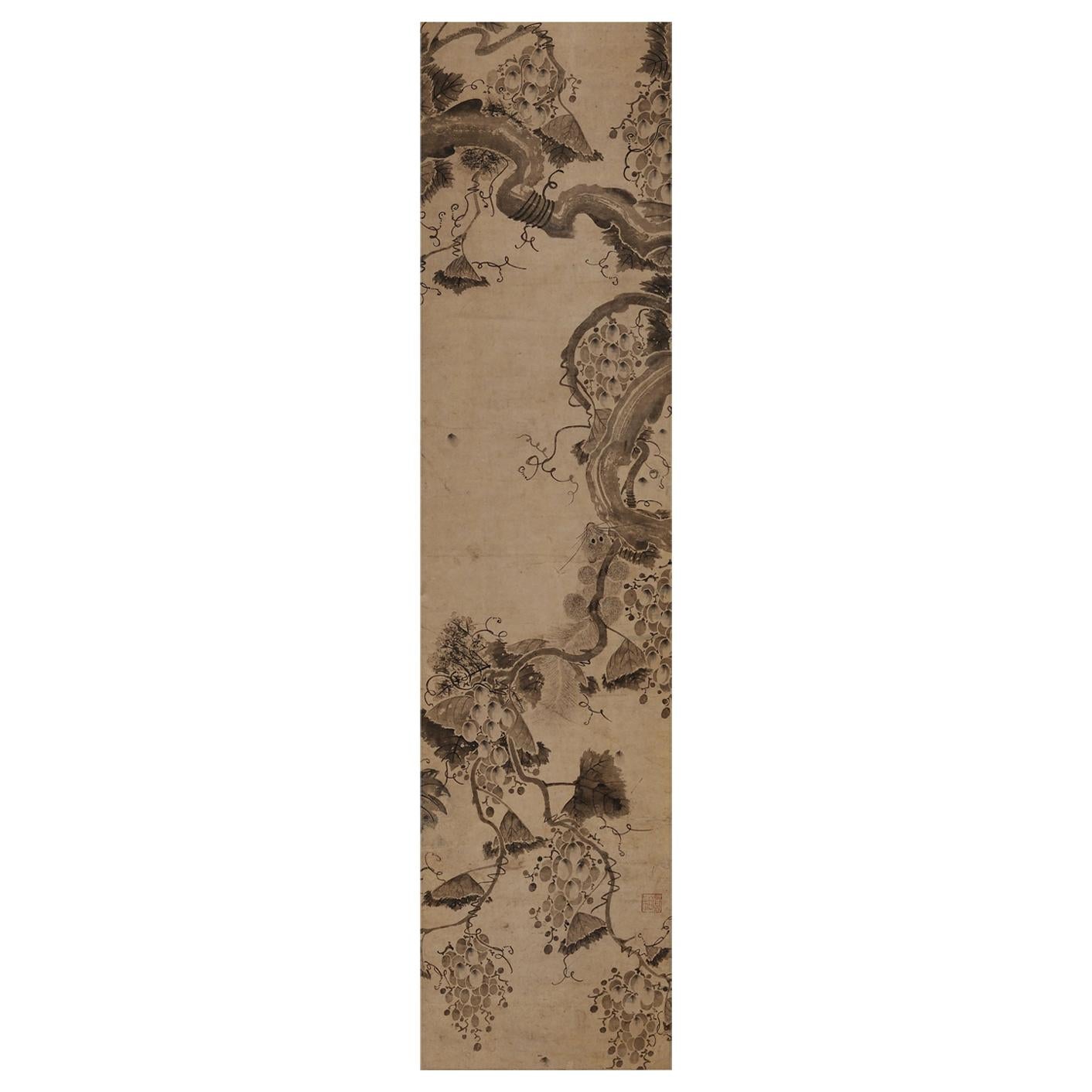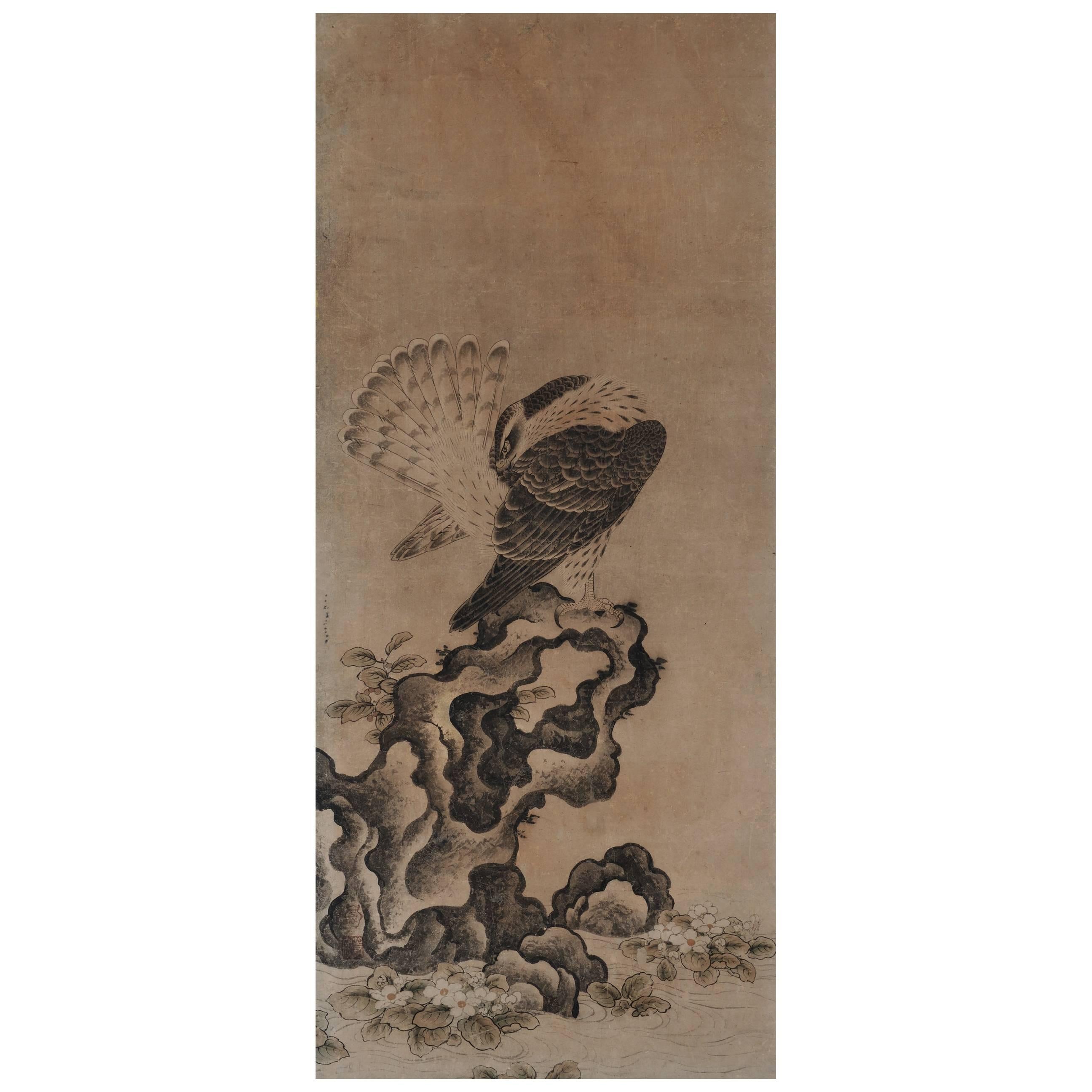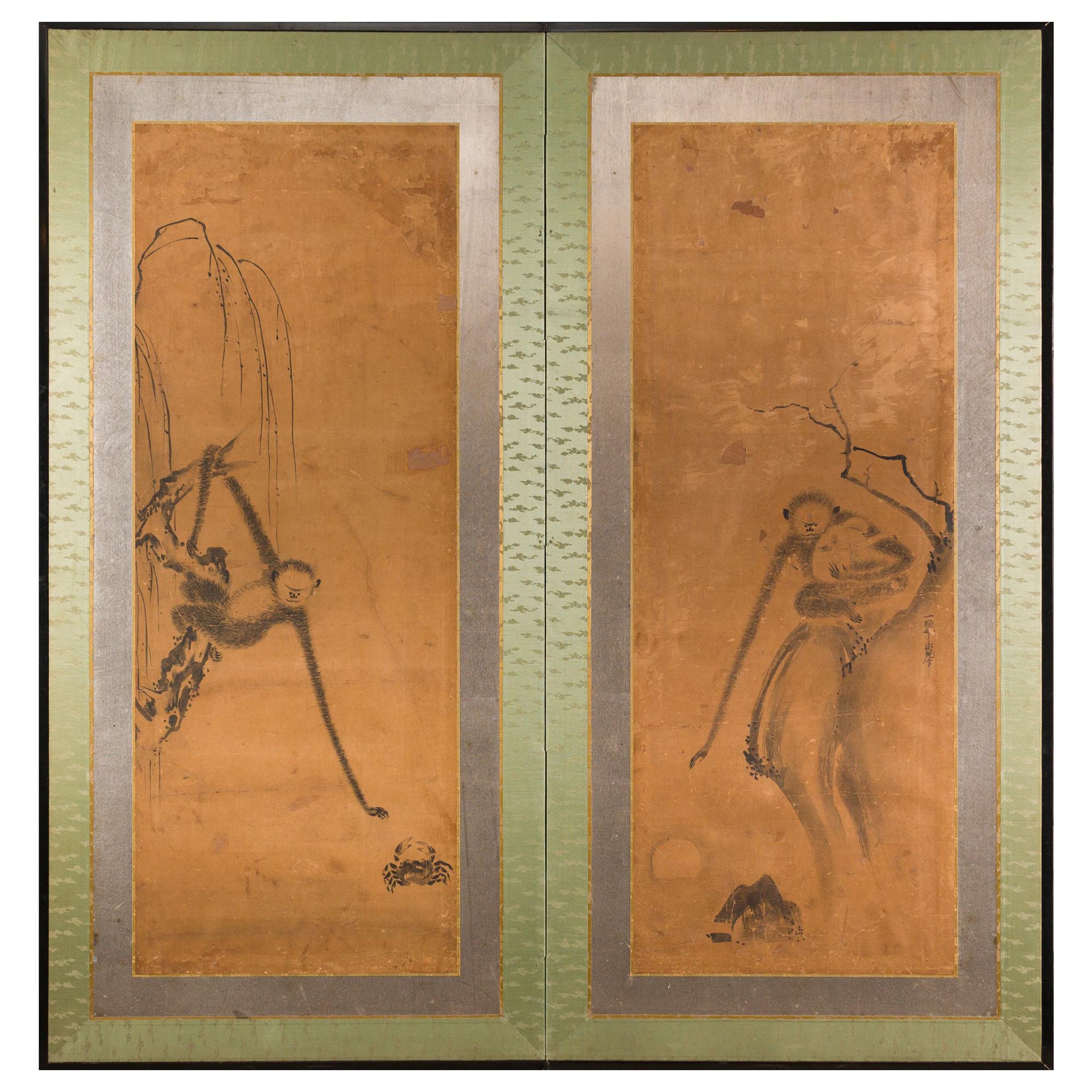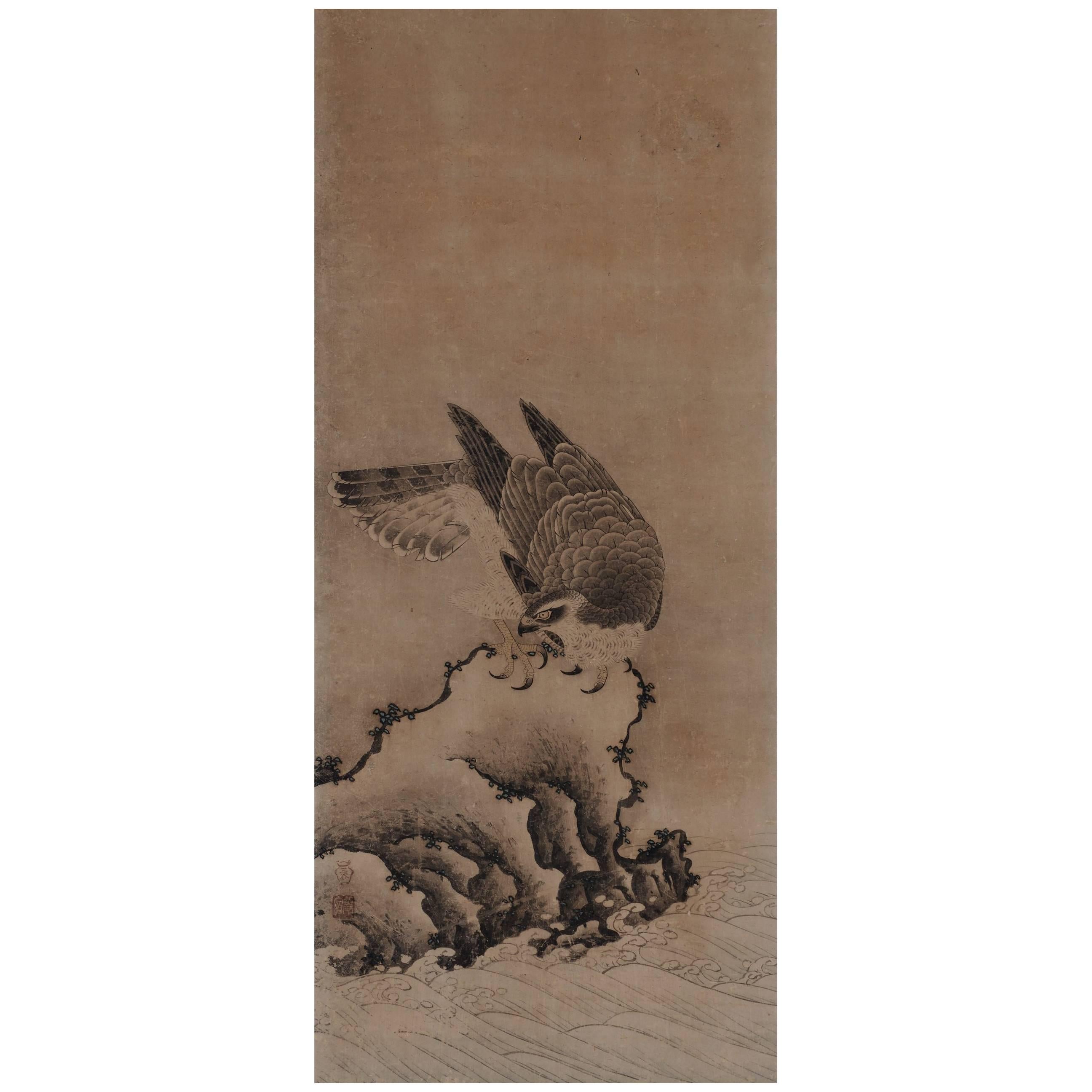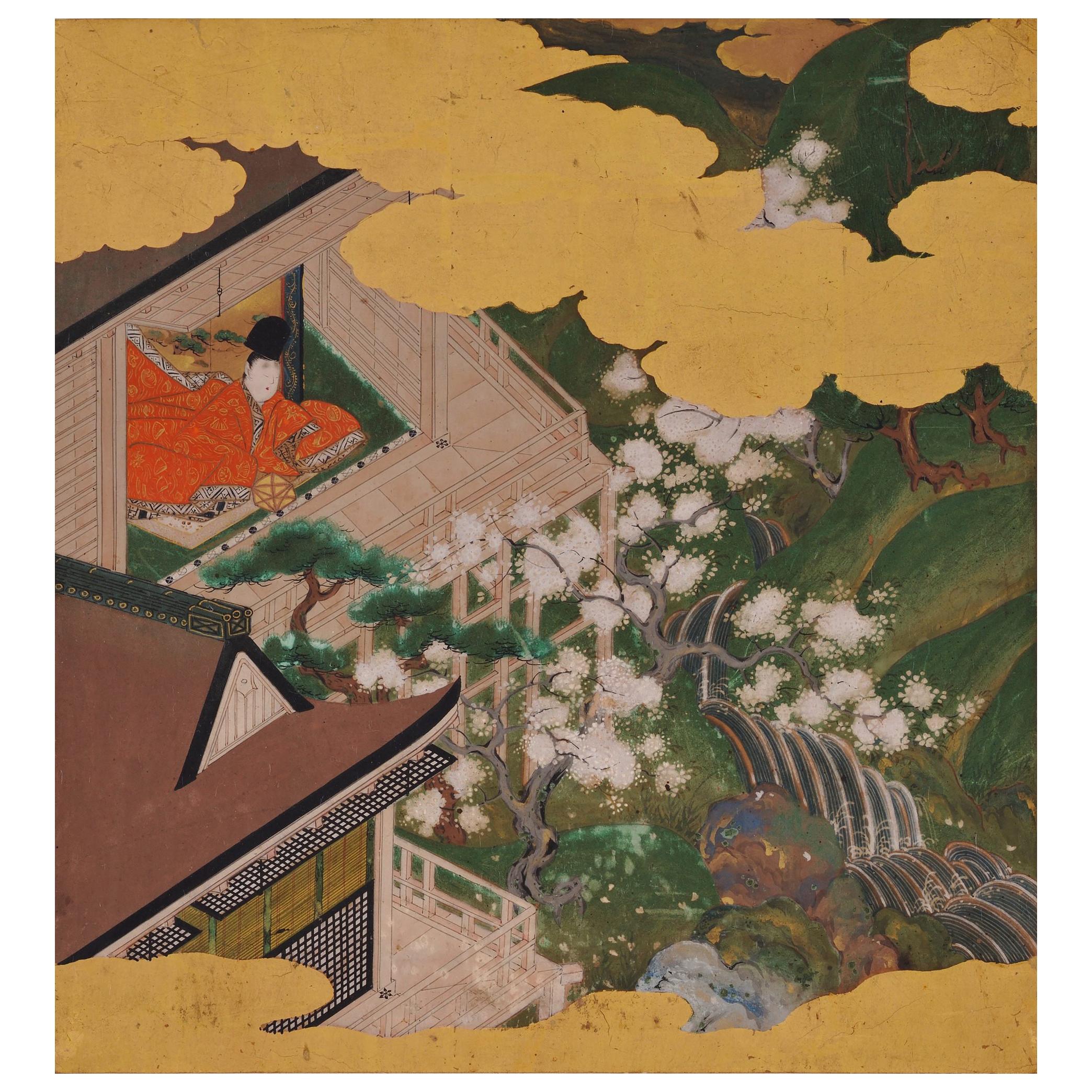Items Similar to Korean Painting, Wall Panel, 17th Century Ink Grapevine
Want more images or videos?
Request additional images or videos from the seller
1 of 7
Korean Painting, Wall Panel, 17th Century Ink Grapevine
About the Item
Grapevine
Anonymous. Korean, 17th century.
Wall panel, ink on paper.
Upper seal:
Kou Kinun in
Lower seal:
Kaigen
Dimensions:
Measures: 98.5 cm x 29.5 cm (39” x 11.5”).
The painting is mounted on a strong, lightweight wooden lattice frame, prepared with multiple layers of Japanese washi paper. The panel is edged with antique gold leaf paper. The techniques are traditional and archival.
The grape, not indigenous to Korea, was considered rare and exotic and the subject of grapevines rendered in ink was popular among literati painters throughout the Choson period (1392-1910). That these plants could be rendered monochromatically with simple ink and a calligraphic brush made them especially favored subjects for literati artists, whose lives revolved around the arts of the brush: poetry, calligraphy, and paint¬ing. The twisting vines, curling tendrils and round, plump grapes provided ample opportunity for expressive "brush play."
This 17th century work is Minimalist, offering a close-up view of a grapevine rendered with an air of spontaneity and a calligraphic elegance. The elements themselves are quite realistic, though the composition is intimate with atmosphere and effect predominant. Ink palette helps build compositional space more profoundly than any organising principal. Without evocative mists and linear gradations the artist goes rapidly and efficiently to the point, abstracting the scene. Leaving three quarters of the surface empty, the artist relies strongly on negative space. The perspective is quite austere, though the deliberately uncentered composition has a fluid rhythm. The grapevine springs up from nowhere, emerging from one side of the canvas and disappearing just as abruptly into another.
- Dimensions:Height: 39 in (99.06 cm)Width: 11.5 in (29.21 cm)Depth: 0.75 in (1.91 cm)
- Style:Other (Of the Period)
- Materials and Techniques:
- Place of Origin:
- Period:
- Date of Manufacture:17th Century
- Condition:Refinished. Wear consistent with age and use. Conservation and re-mounting undertaken in Kyoto utilizing traditional techniques and craftsmen.
- Seller Location:Kyoto, JP
- Reference Number:1stDibs: LU2472312548091
About the Seller
5.0
Recognized Seller
These prestigious sellers are industry leaders and represent the highest echelon for item quality and design.
Gold Seller
These expertly vetted sellers are highly rated and consistently exceed customer expectations.
Established in 2001
1stDibs seller since 2016
60 sales on 1stDibs
Typical response time: 6 hours
- ShippingRetrieving quote...Ships From: Kyoto, Japan
- Return PolicyA return for this item may be initiated within 10 days of delivery.
More From This SellerView All
- 17th Century Korean Grapevine and Squirrel Scroll Painting, Mid Joseon PeriodLocated in Kyoto, JPAnonymous. Korean, 17th century. Joseon period. Hanging scroll. Ink on paper. Seal: Shinso Dimensions: Scroll: H. 200 cm x W. 31 cm (79” x 12”) Image: H. 122 cm x W. 29.5 cm (48” x 11.5”) The grapevine came to China and then Korea from western Asia via the silk road trade routes. By the mid-Joseon period, it was one of the most popular subjects for Korean literati painters. Grapevines were painted as a singular subject or, less commonly, in combination with squirrels, which are associated with children due to their playful nature. Together, grapevines and squirrels embody wishes for abundant offspring and wealth. For the Korean literati artist the twisting vines, curling tendrils and round, plump grapes provided ample opportunity for expressive "brush play”. In this painting the artist has abstracted the scene and is seemingly unconcerned with discontinuities and proportion. Vines spring up from nowhere, grapes hang in random clusters and the squirrel’s head appears as if twisted backwards. For the vines and leaves we can feel a sense of speed in the brushstrokes, imparting a dynamic feel which is at once intense and animated. This contrasts dramatically with the countless tiny strokes of ink which realistically capture the texture of the squirrel’s fur...Category
Antique 17th Century Korean Other Paintings and Screens
MaterialsPaper
- Japanese Painting, Framed Panel, 17th Century Falcon by Mitani ToshukuBy Mitani ToshukuLocated in Kyoto, JPMitani Toshuku (1577-1654) “Falcon” Wall panel, ink and light color on paper. Upper seal: Mitani Lower seal: Toshuku Dimensions: Each 118.5 cm x 51 cm x 2 cm (46.5” x 20” x .75”) Individual falcon paintings by Mitani Toshuku (1577-1654), an early artist of the Unkoku School. Founded by Unkoku Togan (1547–1618), a master of the Momoyama period, the Unkoku school enjoyed long lasting patronage in southern Japan. Togan was a retainer of the Mori family in present day Yamaguchi prefecture. Members of the school considered themselves to be in the artistic lineage of Sesshu Toyo...Category
Antique Early 17th Century Japanese Edo Paintings and Screens
MaterialsWood, Paper
- 17th Century Japanese Screen. Ink Plum Tree & Birds by Kano Naonobu.Located in Kyoto, JPKano Naonobu (1607-1650) Plum Tree and Birds Six-fold Japanese Screen. Ink and slight color on paper. In this evocative ink work spread over a six-panel folding screen, we see the consummation of the elegance and refinement of the Edo Kano school. This 17th century screen is a rare surviving example of a large-scale bird and flower painting by Kano Naonobu, the younger brother of Kano Tanyu...Category
Antique 17th Century Japanese Edo Paintings and Screens
MaterialsWood, Paper
- 17th century Japanese Falcon Painting, Mitani Toshuku, Unkoku SchoolBy Mitani ToshukuLocated in Kyoto, JPMitani Toshuku (1577-1654) “Falcon” Wall panel, ink and light color on paper. Upper Seal: Mitani Lower Seal: Toshuku Dimensions: Each 118.5 cm x 51 cm x 2 cm (46.5” x 20” x .75”) Individual falcon paintings by Mitani Toshuku (1577-1654), an early artist of the Unkoku School. Founded by Unkoku Togan (1547–1618), a master of the Momoyama period, the Unkoku school enjoyed long lasting patronage in southern Japan. Togan was a retainer of the Mori family in present day Yamaguchi prefecture. Members of the school considered themselves to be in the artistic lineage of Sesshu Toyo...Category
Antique Early 17th Century Japanese Edo Paintings and Screens
MaterialsPaper
- Japanese Painting, 17th Century, Tale of Genji, Tosa SchoolLocated in Kyoto, JPIllustration to an unidentified chapter of the Tale of Genji (Genji Monogatari) Tosa School (second half of the 17th Century) Ink, pigment, gofun and...Category
Antique Late 17th Century Japanese Edo Paintings and Screens
MaterialsGold Leaf
- 17th Century Japanese Framed Panel by Kano Sansetsu, White Herons in SnowLocated in Kyoto, JPKano Sansetsu (1589-1651) White herons in snow Edo period, circa 1640 Framed painting. Ink on paper. Kano Sansetsu is a Japanese painter who ...Category
Antique 17th Century Japanese Edo Paintings and Screens
MaterialsPaper
You May Also Like
- 17th Century Japanese Two-Panel Screen, Gibbons of FolkloreLocated in Hudson, NYJapanese two-panel screen: Gibbons of Folklore, Edo period (17th century) Kano School painting of gibbons in Japanese fables. The left panel represents a Japanese fable of a monkey a...Category
Antique Late 17th Century Japanese Edo Paintings and Screens
MaterialsSilk, Wood, Paper
- Late 17th-Early 18th Century Japanese Six-Panel Screen, Battle at Uji BridgeLocated in Hudson, NYJapanese six-panel screen: Battle at Uji Bridge, the first battle at Uji was in 1180 and it marked the start of the Heike Wars. The Genji troops crossed the...Category
Antique Late 17th Century Japanese Edo Paintings and Screens
MaterialsGold Leaf
- Chinese Early Qing Dynasty "Water and Land Ritual" Painting, 17th CenturyLocated in Austin, TXAn important Chinese 17th century early Qing Dynasty "Water and Land Ritual" painting, mineral pigment and ink on silk, mounted as a scroll, framed and glazed. The painting depicting groups of heavenly court officials and deities descending from the clouds to participate in the Liberation Rite of Land and Water. The figures all wear full, sumptuous robes, complete with hats indicating their station. The blue, green, red, black and white of the robes decorated with gilt dragon and geometric designs. This painting is interesting in that it incorporates Daosit deities and heavenly officials coming down to participate in the Buddhist rite. There are five distinct groups of figures, each with a small inscribed plaque. Some of the groups are identified as Tian Xian, or Heavenly Immortals. The group at the bottom left are identified as the Sanguan Dadi, or Three Great Emperor-Officials. The Emperor of Heaven is dressed in blue robes with gilt painted dragons. The Emperor of Water wears black robes. The Emperor of Earth wears yellow robes...Category
Antique 17th Century Chinese Qing Paintings and Screens
MaterialsSilk, Glass, Giltwood, Paint
- Japanese Antique Ink Painting / 19th Century / Rare Chinese Character PaintingLocated in Sammu-shi, ChibaWe have a unique Japanese aesthetic sense. And only we can introduce unique items through our purchasing channels in Japan and the experience we have gained so far, in such a way that no one else can imitate. It is an ink painting written after the Meiji era. The biggest attraction of this work is that it uses Chinese characters to create paintings. To explain in detail, it is written here in Chinese characters as "un-ryu" . "Un" is a cloud and "ryu" is a dragon. These are embodied and drawn by comparing them to the meaning of Chinese characters. And the clouds depict the clouds hanging over the mountain, and the dragon depicts the climbing toward the mountain. Humorous paintings...Category
Antique Late 19th Century Japanese Edo Paintings
MaterialsAcrylic, Paper
- Korean Six-Panel Screen of Legendary Chinese FiguresLocated in Rio Vista, CAMeiji period Korean six-panel screen depicting legendary Chinese figures on individual panels with birds and blossoming flowers. Each panel is signed Kakusai (studio of the crane) in...Category
20th Century Korean Meiji Paintings and Screens
MaterialsWood, Silk, Paper
- Korean Showa Four Panel Screen Tartars Hunting LandscapeLocated in Rio Vista, CAMagnificent Korean Showa period four-panel screen depicting hunting scenes with tartars in a mountain landscape. The screen is decorated with vibrant ink and natural color pigments o...Category
20th Century Korean Showa Paintings and Screens
MaterialsBrass
Recently Viewed
View AllMore Ways To Browse
Antique Wall Panels
Antique Wall Panel
17th Panel
17th Century Panel
17th Gold
17th Century Gold
Rare Art Panels
Asian Ink Art
Asian Paintings On Wood
Antique Panel Paintings
Painted Wall Screen
Asia Gold Painting
Asian Painting Gold Art
Traditional Asian Painting
Lattice Frame
Antique Asian Wall Art
Screens And Wall Panels
Panel Wall Screen
